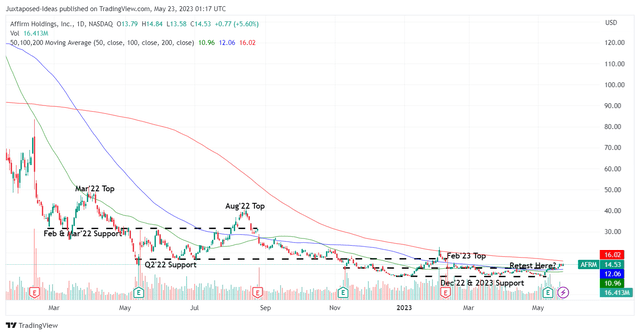Summary:
- AFRM continues to post underwhelming top and bottom line expansion thus far, likely attributed to the intensifying competition in the BNPL space.
- Then again, while its FQ3’23 performance appears to be lacking, we may see a quick reversal by FQ4’23, attributed to its expanding interest income from the raised APRs.
- Combined with the restructuring in February 2023, we may see AFRM’s losses narrow in the near term, though adj/GAAP profitability likely remains a moonshot for now.
Dilok Klaisataporn
The AFRM Investment Thesis Remains Speculative
Affirm (NASDAQ:AFRM) stock has posted underwhelming FQ3’23 results, with net revenues of $380.98M (-4.6% QoQ/+7.3% YoY) and widening losses of adj EPS of -$0.57 (+47.2% QoQ/-200% YoY). Its FY2023 revenue guidance of $1.54B (+14.9% YoY) similarly reflects a drastic deceleration compared to its historical YoY cadence of +55% in FY2022 and +70.8% in FY2021.
While part of the latter may be attributed to the tightened discretionary spending due to the rising inflationary pressures, we suppose most of it may be a result of the intensified competition arising in the Buy Now Pay Later (BNPL) segment thus far.
As a reference, AFRM processed $4.63B (-18.5% QoQ/+18.4% YoY) of Gross Merchandise Volume in the latest quarter.
In comparison, PayPal Holdings (PYPL) recorded $6B of BNPL volume in Q1’23 (-14.2% QoQ/+70% YoY), with Block (SQ) similarly expanding its BNPL volume to $5.6B (+18% YoY). Combined with other BNPL/financing options from Big Techs, such as Apple (AAPL) and Alphabet (GOOG) (GOOGL), it appears that AFRM has no moat after all.
This is on top of the supposed “loss of exclusivity” with Amazon (AMZN), though AFRM has also confirmed that the GMV attributable to the former does not exceed 20% of its total GMV by the latest quarter.
AFRM Transaction Costs & Loans On Balance Sheet
Either way, AFRM’s prospects look uncertain as well, with the recent banking crisis likely tightening its funding sources. In FQ3’23 alone, the transaction costs have risen to 4.6% (+0.1 point QoQ/+0.2 points YoY) and funding costs to $51.18M (+16.9% QoQ/+223.5% YoY). This is on top of the growing loans held on its balance sheet at $3.11B at the same time (-15.7% QoQ/+23.4% YoY).
Its provision for credit losses has also accelerated to $237.37M (+122.5% QoQ/+30% YoY), with net charge-offs growing to $41.95M (+119.6% QoQ/+20% YoY) by the latest quarter.
Combined with the FQ4’23 guidance of increased loan delinquency rate and credit losses, it is unsurprising that we are uncertain about AFRM’s prospects, worsened by the deterioration of its balance sheet at cash/short-term investments of $972.48M (-40% QoQ/-57% YoY) in FQ3’23.
Then again, AFRM has taken notable steps to improve its profitability by expanding its interest-bearing GMV to 69% by FQ3’23 (+2 points QoQ/+12 YoY), naturally improving its interest income to $178.27M (+14.7% QoQ/+32.4% YoY) by the latest quarter.
This cadence is particularly attributed to its shift in pricing initiatives by increasing the APR for loans from the previous 0% programs to merchant-subsidized low APR loans of between 4% and 9.99%. This is on top of expanding its maximum APR from 30% to 36%.
Since interest income accounts for a growing part of AFRM’s net revenues at 46.7% in the latest quarter (+7.9 points QoQ/+8.8 YoY), it is also unsurprising that its funding capacity continues to expand to $11.4B (+8.5% QoQ/+26.6% YoY). This cadence demonstrates that the fintech’s capital market partners are increasingly confident in the company’s execution despite the peak recessionary fears.
Combined with the management’s guidance of doubled progress in the pricing initiatives in the intermediate term, we may see its profitability improve over time, well-balanced by the moderation in its operating expenses to $442M (-12.2% QoQ/+11.3% YoY) and the accretive impact of its restructuring by FQ4’23.
Therefore, we may see AFRM’s losses narrow by the next quarter, triggering moderate tailwinds to its stock performance.
So, Is AFRM Stock A Buy, Sell, Or Hold?
AFRM 1Y Stock Price
For now, AFRM has already swiftly rebounded from its 2023 support levels of $9s and broke its next resistance levels of $12s. However, given the uncertain macroeconomics and the massive short interest of 21.97% at the time of writing, we believe the stock may remain volatile or worse, retrace in the near term.
Therefore, while the stock may look attractive here, investors may only add if the exercise consequently lowers their dollar cost average. Otherwise, we prefer to prudently rate AFRM as a Hold here, since the economic downturn may only lift by 2024, if not 2025, giving investors plenty of chances for adding at more attractive levels.
Furthermore, market analysts continue to project minimal profitability over the next few years, with minimal positive FCF by FY2024 and negative adj/GAAP EPS through FY2027, suggesting the stock’s underperformance over the next few quarters.
Analyst’s Disclosure: I/we have a beneficial long position in the shares of AAPL, GOOG, AMZN, PYPL either through stock ownership, options, or other derivatives. I wrote this article myself, and it expresses my own opinions. I am not receiving compensation for it (other than from Seeking Alpha). I have no business relationship with any company whose stock is mentioned in this article.
The analysis is provided exclusively for informational purposes and should not be considered professional investment advice. Before investing, please conduct personal in-depth research and utmost due diligence, as there are many risks associated with the trade, including capital loss.
Seeking Alpha’s Disclosure: Past performance is no guarantee of future results. No recommendation or advice is being given as to whether any investment is suitable for a particular investor. Any views or opinions expressed above may not reflect those of Seeking Alpha as a whole. Seeking Alpha is not a licensed securities dealer, broker or US investment adviser or investment bank. Our analysts are third party authors that include both professional investors and individual investors who may not be licensed or certified by any institute or regulatory body.


